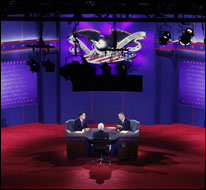What does the profile of the average American “undecided” voter look like? It’s a question asked by many who closely follow politics, usually incredulous that a citizen could still not have chosen sides close to Election Day, despite the tsunami of political ads and media coverage. In campaign 2012, of course, the topic became ripe for satire, as Saturday Night Live demonstrated.
As a general rule, political scientists find that undecided voters are less involved in politics, less informed on issues, less attentive to news — and much harder to reach through media streams. Many vote in presidential election years but not in lower-profile mid-term elections; and many will, if asked, describe themselves as independent voters.
An element of analytical caution is in order: In September 2012 it was assumed by many in political circles that the electorate had hardened in its views and there was an increasingly narrow band of undecided voters. Yet, movement in the post-presidential debate polls strongly suggested that prior survey research underestimated the size of the undecided population — or at least those who were “persuadable.”
A Washington Post poll conducted Oct. 10-13 — a random survey of 1,252 adults, with an error margin of 3.5 percentage points — suggested that 9% of likely voters say there is still a “chance” they would change their mind. But of those, 7% said such a switch remains “unlikely.” As of late August, the Post’s poll found that 15% of registered voters said there was still a chance they would change their minds; and 19% expressed similar sentiments in a July poll.

UCLA political scientist Lynn Vavreck has been following trends among a large group of American voters throughout 2012, and she’s found that undecided voters make up roughly 4% to 5% of the electorate. About 60% of this group in this election cycle are women. (See Katharine Q. Seelye’s piece in the New York Times on female swing voters.) Vavreck and political scientist Larry Bartels provided a detailed snapshot of partisan leanings of undecided voters several months before the election. As Vavreck told NPR in October, the issue isn’t so much indecisiveness or confusion as available time to focus on politics: “It isn’t that they’re looking at Mitt Romney and looking at Barack Obama and weighing them. They’re not looking yet.” She notes that among the group of voters she’s studied, roughly 7% have changed their mind over the course of the year, moving from Romney to Obama, or vice versa.
Although undecided voters on average may be less politically informed, “The Monkey Cage” political science blog points out that some undecided voters have strong partisan leanings and well-formed views on issues: “One of the stupider things that people say about undecided voters is that they’re stupid.” (See related posts at that blog: “How Will the Undecideds Break?” and “A Little More on How Undecided Voters Might Break.”) And many voters in general display low information when asked about politics and policy (in such knowledge tests, a key variable is whether local or national questions, or both, are put to voters).
Some recent pieces of journalistic analysis provide insights related to this subject: Ben White’s “Meet the Undecided Voter,” at Politico and Adam Davidson’s “Vote Obamney!” in The New York Times Magazine.
A 2008 academic analysis of the issue, “What Exactly Is a Swing Voter? Definition and Measurement” (PDF) — part of the book The Swing Voter in American Politics by William G. Mayer of Northeastern University — can provide additional historical perspective. The findings of the paper, which analyzes American National Election Studies survey data over the period 1972-2004, include:
- “In every single survey, there is a large and statistically significant difference, in exactly the direction predicted: swing voters are less partisan…. Those at the more extreme ends of the ideological spectrum, we might suspect, have a clearer affinity for one of the major-party candidates: liberals for the Democrat, conservatives for the Republican. Moderates, by contrast, are less certain about which nominee better represents their opinions and interests and thus more likely to waver. At the level of ideological self-description, this hypothesis has a considerable measure of truth. The National Election Studies generally measure ideology on a seven-point scale, ranging from extreme liberals to extreme conservatives…. [S]wing voters are more likely to come from the center of the scale and less likely to be found on the extremes than are nonswing voters, a difference that is highly significant in every survey.”
- “The relationship between being a swing voter and being a moderate gets a good deal weaker, however, when one examines attitudes about specific issues. If one looks closely at the responses to questions on such topics as job guarantees or the best way to provide health care, swing voters are slightly less likely to be found at the extremes on such issues, more likely to be near the center, but the differences are rather small.”
- “Swing voters, no matter how one defines them, are consistently less involved in and informed about politics than the rest of the electorate…. As a generalization, then, one can say that although swing voters are a bit more difficult to reach than nonswing voters, they are not so isolated or apolitical as to make the campaigner’s task impossible. In fact, swing voters watch presidential debates in about the same percentages as nonswing voters and are actually more likely to report seeing a political advertisement.”
- “To the extent that swing voters are demographically different from nonswing voters, moreover, their distinctive attributes vary from election to election. The only group that is overrepresented among swing voters in at least eight of nine elections [1972-2004] is Catholics…. If there is one group that is most often described as a swing constituency in media stories, it is women. Yet not once in these nine elections do women emerge as significantly more likely to be swing voters. To the contrary, in 1996, 2000, and 2004, it was men who were more likely to be swing voters (though the difference never quite achieves statistical significance).”
A related 2012 study by the same author, “The Disappearing — but Still Important — Swing Voter,” provides additional insights on the subject.
Tags: presidency, research roundup


Expert Commentary